This is how it all started! I was working on our farm near Polo Illinois and my step-mother Rose told me that there might be a job for me in Freeport where she was working as a secretary.
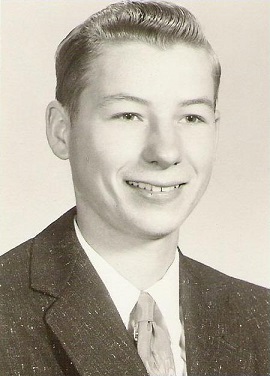 I interviewed at Burgess Battery, but without any experience, believed my chances of getting the job was nil. After a month had gone by I had forgotten about the job, no day dreaming at that point in time.
Then I heard my step-mother yelling for me from the house that there was a phone call from me from Freeport, long distance. I wondered who that could be! She was as excited as I was!
I interviewed at Burgess Battery, but without any experience, believed my chances of getting the job was nil. After a month had gone by I had forgotten about the job, no day dreaming at that point in time.
Then I heard my step-mother yelling for me from the house that there was a phone call from me from Freeport, long distance. I wondered who that could be! She was as excited as I was!
It was Burgess Battery and they wanted me to come to work for them in their computer center. The building was located on the Pecatonica River on the edge of Freeport and produced dry cell batteries.
The next week they sent me to Chicago to IBM school to learn how to wire, or program the boards that tabulated the punched cards used in those days. (See the photos below!) They put me in a hotel in downtown Chicago and I was in seventh heaven. The hotel was about 25 stories tall and even had a swimming pool on the roof!
Can you believe it, one day in the barn on the farm, the next day in a high rise hotel in Chicago going to IBM school! Little did I know this would lead to a life time job in the computing world, ending up in San Francisco and consulting for the major corporations in the Bay Area!
I retired when I hit the magic number '62' and decided to start traveling and doing all the things I couldn't do while I was working in the computer industry. I was especially busy during the last ten years of work when I was consulting on software development and working on projects like the Y2K fix for Banc of America. Check out my resume to see how my career began in the 1959 through 2025!
1959 - Resume - 2025 & Beyond
The Freeport & Rockford Illinois Years ~ 1959 to 1963
I first worked at Burgess Battery In Freeport for over a year. Then I worked for Anderson Brothers, a very small
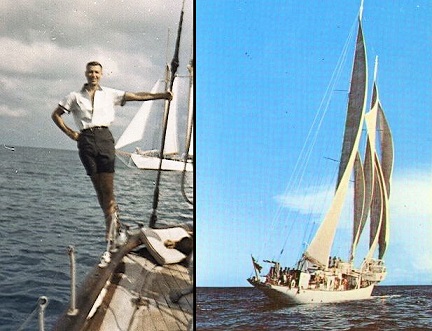 company in Rockford that manufactured machine tools. The last job I had was at Amerock in Rockford and my boss there wanted me back there after my military service. They did have a large installation when I was drafted but after seeing San Francisco and the Pacific Ocean and of course, Los Angeles, Hollywood and Monterey, I was hooked, never to return to the Midwest!
One evening after work, I was sitting in a bar having a cocktail before going home for dinner. There on the TV was an announcer stating there were missiles 90 miles off the coast of Florida and pointed at the major cities along the Atlantic Coast. Needless to say I wondered what that meant! Well shortly after I received a special letter in the mail stating I needed to go for the induction process to enter the Army! I was not a happy camper but as you will see, things did turn out all right!
company in Rockford that manufactured machine tools. The last job I had was at Amerock in Rockford and my boss there wanted me back there after my military service. They did have a large installation when I was drafted but after seeing San Francisco and the Pacific Ocean and of course, Los Angeles, Hollywood and Monterey, I was hooked, never to return to the Midwest!
One evening after work, I was sitting in a bar having a cocktail before going home for dinner. There on the TV was an announcer stating there were missiles 90 miles off the coast of Florida and pointed at the major cities along the Atlantic Coast. Needless to say I wondered what that meant! Well shortly after I received a special letter in the mail stating I needed to go for the induction process to enter the Army! I was not a happy camper but as you will see, things did turn out all right!
I had never seen the ocean or anything other than the midwest in 1962. For some reason when I was 22 and working at Amrock in Rockford Illinois, I suddenly decided to go on a cruise in the
Bhamas for two weeks over New Years. I saw an article in a magazine about the famous Windjammer sailing vessels and their itineraries! What a fantastic trip, this was the beginning of me wanting to go all over the world to see things I had always read about.
The IBM 405 Alphabetical Accounting Machine, 1934. This was IBM's high-end tabulator offering (and the first one to be called an Accounting Machine), complementing its numeric-only 285. The 405 was programmed by a removable plug board with over 1600 functionally significant "hubs", with access to up to 16 accumulators, the machine could tabulate at a rate of 150 cards per minute, or tabulate and print at 80 cpm. The print unit contained 88 type bars, the leftmost 43 for alphanumeric characters and the other 45 for digits only. The 405 was IBM's flagship product until after World War II (in which the 405 was used not only as a tabulator but also as the I/O device for top-secret relay calculators built by IBM for the US Army Signal Corps in 1943, used for decrypting German and Japanese coded messages). In 1952, IBM first used core memory in an experimental 405 model.
|
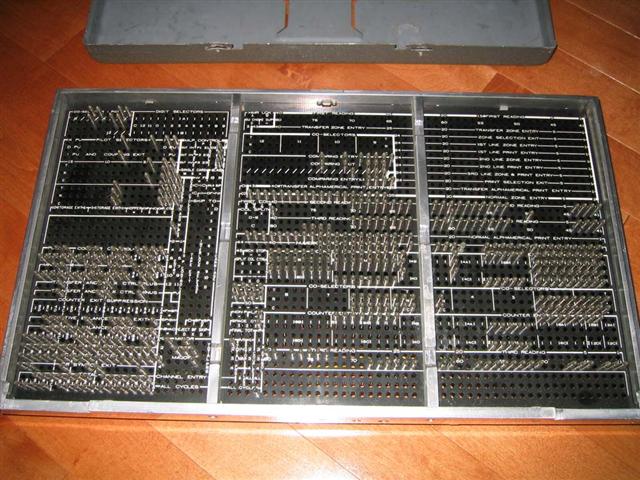 |
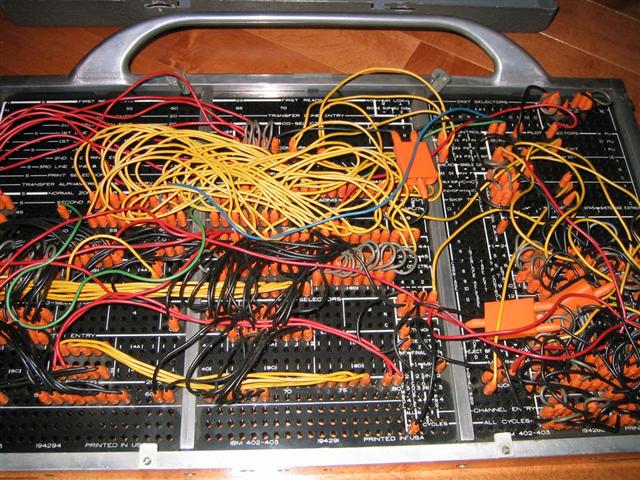 |
|
This is the top of the board that we wired to create the tabulation for reporting. |
And this is the reverse side where the metal plugs met the receptors in the computer to relay the instructions. |
IBM Wiring Boards:
I was sent to Chicago in the fall of 1959 to learn how to wire these control panels for my first job in the computer industry!
The very first punched-card tabulating machines were custom-built to do just one job, such as tally the US 1890 or 1900 census data. Starting in 1906, tabulators were made more flexible by addition of a wiring panel to let users control their actions to some degree, thus allowing the same machine to be sold into different markets (government, railroad, etc) and used for different purposes. But this also meant that if one machine were to be used for different jobs, it would have to be rewired between each job, often a lengthy process that kept the machine offline for extended periods. In 1928, IBM began to manufacture machines with removable wiring panels, or "plugboards", so programs could be prewired and swapped in and out instantly to change jobs. The plugboard fits into a receptacle in the machine.
By the 1930s, most IBM punched-card equipment -- tabulators, accounting machines, multiplying and summary punches, calculators -- operated under the control of a plugboard, now formally referred to as a control panel. Users wired plugboards to specify exactly which card columns were to be read or punched, which card fields were to be fed to which accumulators, and so forth, depending on the machine. The instructions were given by connecting holes ("hubs") with wires. For example, a simple task on an accounting machine might be to print columns of numbers from a deck of cards, in which case a series of wires would connect card columns to printer columns. A slightly more ambitious version of this task would also accumulate totals by connecting the same card columns to accumulators, and then print the totals at the end.
Presidio of San Francisco California ~ Military ~ 1963 - 1965
|
The photo on the left is a view of the barracks I lived in during my stay in the military at the Presidio! The second photo is a view from Crissy Field where the computer center was located with a nice beach and the City and bridge in the back ground |
1965 ~ Chuck as a Specialist 4 Rank in the Presidio Computer Center. We managed all of the military equipment for the Western Region, Alaska and Hawaii. |
IBM 402/403
|
 |
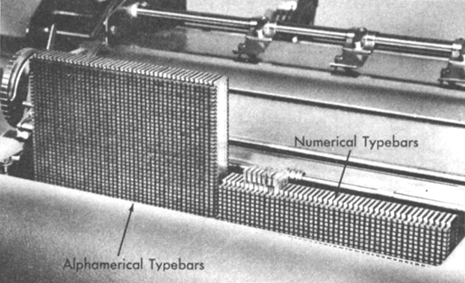 |
The IBM 402 accounting (tabulating) machine, 1948, was an "improved and modernized successor to the 405 accounting machine, the choice of type number notwithstanding". The 400 series of machines was used to read standard 80-column IBM cards (at speeds of 80 to 150 cards per minute, depending on options),
accumulate sums (of positive and/or negative numbers), subtotals, and balances, and to print reports on its integrated printer, all under control of instructions wired into its control panel, that specified which card columns to accumulate in which counters and how to format the report. The 402 rented for $290 per month in 1955.
The 402 series, like the 405 before it, used a type bar print mechanism, in which each column (up to 88, depending on model and options) has its own type bar. Long type bars (on the left in this photo) contain letters and digits; short ones contain only digits (each kind of type bar also includes one or two symbols such as ampersand or asterisk). Type bars shoot up and down independently, positioning the desired character for impact printing. The arrangement of type bars suggests the most common application for these machines: spreadsheet-like columns of numbers, with alphabetic labels for each row on the left.
2014 - I just found a photo of the first mass storage for data that Amrock Manufacturing of Rockford Illinois bought in 1962. I was working there in 1962 and 1963, just before I was drafted. That was the first mass storage unit I had seen and it would be years before I saw anything like it again. Firemanís Fund used tapes for years, up to 18,000 before they went to disk packs, and that was in the 1970s! Can you believe it, $120,000.00 to store 5 Megabytes and in 2013 for $60.00 you can store 65,536 Megabytes!
My manager at Amrock liked me so much he continued to call my sister who lived in Rockford, to ask when or if I was moving back to Rockford and to Amrock? She said probably never!
Note:
After working in various companies around northern Illinois in the computer field, I was drafted in the Army during the Cuban Missile Crisis in 1963. Since my IQ test scores were extremely high and I had computer experience, the military wanted me to go to Officers Training to be a Second Lieutenant. My Platoon Sergeant, the First Sergeant and the base commander would get points if someone in basic training was accepted into officer's school. I also came in top shot and won a medal as a sharp shooter, the best out of 800 men! I found out by accident, that I was to be posted to the Presidio in San Francisco overlooking the Golden Gate Bridge! A general's personal aide told me and I was to keep it a secret until I was told I was posted for my two years to the cream of the crop, where all the retiring military went before leaving the army!
So after basic training I was sent to the Presidio of San Francisco to be the swing shift supervisor of the installation situated next to the Golden Gate Bridge. When I landed in San Francisco I thought to myself, this is it, this will be my home for the rest of my life! And all this started from a farm in Illinois in 1959!
IBM 407
|
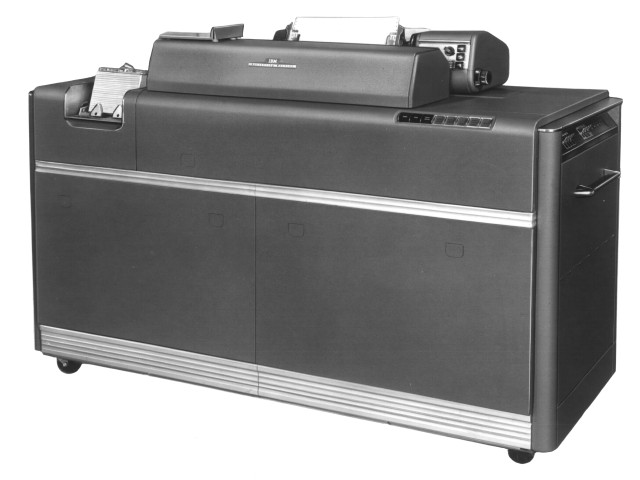 |
The IBM 407 Accounting Machine (1949). This was the last and best of the all-electromechanical IBM accounting machines (previously known as tabulators). The 407 reads a deck of punched cards on their integrated card reader (left), accumulate totals, subtotals, or other simple statistics in counters made of gears, and print the results on their integrated 132-column line printer (center). Speed: 100 to 150 cards per minute (the 407 replaced the earlier typebar printing technology with a much faster print wheel mechanism). As with all IBM punch-card equipment (except the key punch and sorter), a control panel (left) is wired to specify the details of operation: what card columns to read and what to do with them, how to format the report.
|
IBM Service Bureau ~ 1965 - 1966
IBM Check Sorters and IBM 407s
|
 |
The first job I had after leaving the Army was working for the IBM Service Bureau in the Ferry Building. I worked the swing shift and we were bonded and took metal boxes of checks from small banks that IBM had contracts with, and put the checks into the trunk of our cars and drive to another computer center that had the latest check sorting machines.
We would feed the checks into the sorters where they were scanned and edited into bundles. The check numbers and totals were printed for each batch and if the batch did not match the manual total of each batch, we would have to review the batch to determine the error and solve it. This was time consuming and not very much fun.
After a year, many of the banks decided they could afford to do the check balancing themselves or sent them to a central banking office to process checks.
So that was the end of my first job but then I interviewed at Fireman's Fund Insurance, little did I know I would be there for over 15 years!
|
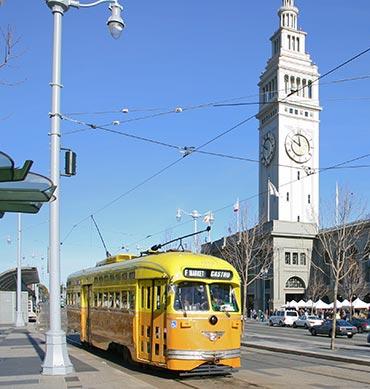 |
Firemen's Fund Insurance Company of San Francisco Years ~ 1966 - 1981
A Montage of Firemen's Fund History!
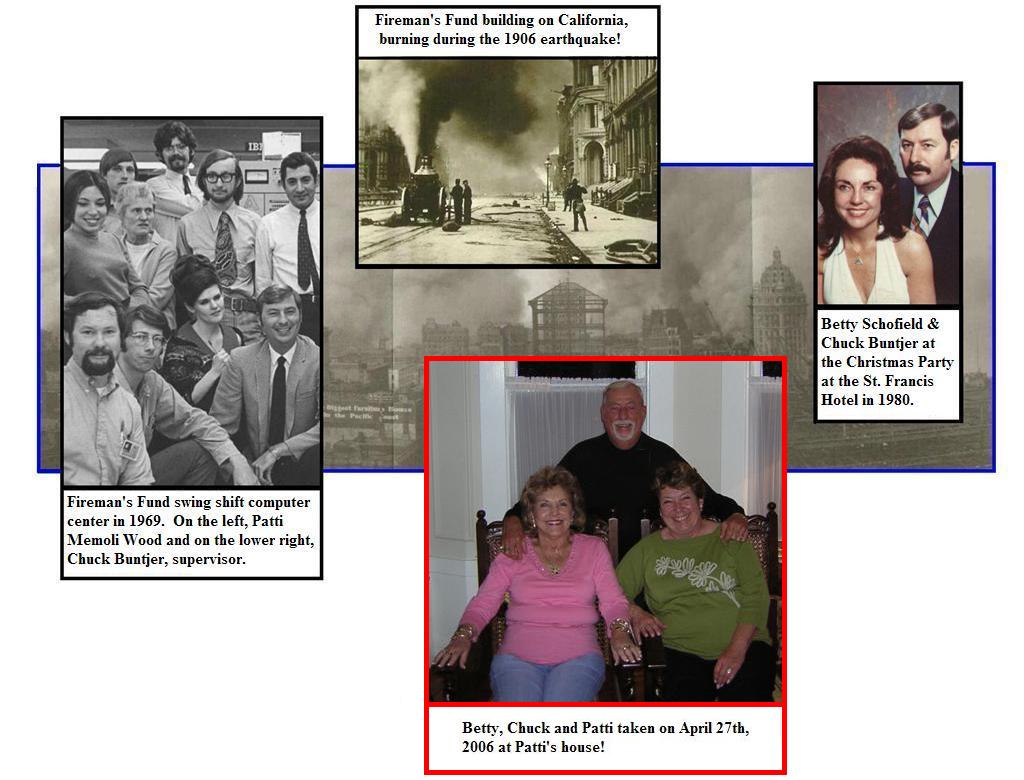
Note:
The following information was supplied by my friend and co-worker Sherrod Holyfield at Fireman's Fund during the 1960s and 1970s. Sherrod was a shift supervisor of the computer installation when I first worked as a computer operator and later as an assistant supervisor.
He told me we had a 1401, 1460 and a 1410. We inherited the 1410 and the 1460 when we merged\took over the American Insurance Company. the 1410 was over by the 7080. The 1460 and the 1401 were on the same wall. The 1460 was closer to the 1410 and the 1401 was originally in the room were the supervisors office was located. That's were it was when you started at the Fund Chuck. It was later moved inside next to the 1460.
Another thought. The 1410 was used almost exclusively to run American Insurance Company (mainly auto & homeowners ins). The only 1410 programmers we had came from the American Insurance side of the house. The fund programmers were 705, 7080 and 1401 Autocoder programmers. Do you remember the problems we had when we bought a program (and several consultants) that converted or tried to covert and recompile all the 705 and 7080 source code from Autocoder to COBOL so we could run the old programs on the NEW generation of IBM machines the great and wonderful 360 series. (remember sys1.flushlib?) As I recall the 40 was the first of the new generation to be brought in and replaced the 1410 and the 1460. My favorite machines to operated were the 705 because of all the blinking lights, the noise of the tapes (remember, the tape drives on the 705 did not re-read what it wrote, so if you had a bad tape, you had to start all over again! The damn thing looked like something right out of a 50's move (DEKSET) also loved the 1401, because I could do quite a bit of programming on it. If we had a problem, the programmer would phone in a patch and I would manually go in and bypass or fix the offending code. Never did like the new generation. You couldn't get and fix things like you could on the old generation.
I may not be in the picture taken of us in front of the IBM System Model 40, because It was about that time that I transferred to the training department.
It was nice of Sherrod to send me the types of computers we had in-house and their locations in the installation and some of the problems associated with running them. Read on for more information and a good photo of us in front of the Model 40!
IBM 705
|
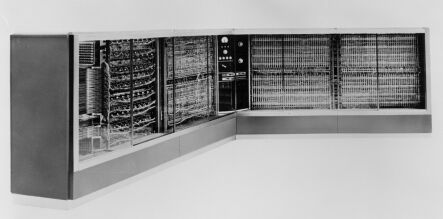 |
The IBM 705 was one of the most powerful data processing systems of the mid-1950s. It was engineered primarily to handle business data. The computer's memory consisted of tiny ferrite cores strung on frameworks of fine wire.
Note:
This model was just being taken out of service when I joined the Fireman's Fund Insurance Company in San Francisco in 1966. I remember we used to laugh as the ferrite rings were strung on the fine wires as stated above but, some wise guy flipped some metal paper clips into the memory and they were hanging and swinging in the breeze as the computer did its final calculations!
|
IBM 1401
|
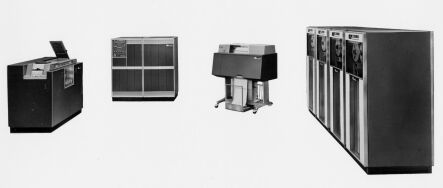 |
Note:
I liked operating the 1401 almost as much as the 1410. Both allowed the operator to run the jobs from the ground up.
|
The following is the text of an IBM Data Processing Division press fact sheet distributed on October 5, 1959.
The all-transistorized IBM 1401 Data Processing System places the features found in electronic data processing systems at the disposal of smaller businesses, previously limited to the use of conventional punched card equipment. These features include: high speed card punching and reading, magnetic tape input and output, high speed printing, stored program, and arithmetic and logical ability.
The elements of the basic 1401 system are the 1401 Processing Unit, 1402 Card Read-Punch, and 1403 Printer. Configurations include a card system, a tape system, and a combination of the two.
The 1401 may be operated as an independent system, in conjunction with IBM punched card equipment, or as auxiliary equipment to IBM 700 or 7000 series systems.
The 1401 performs functions previously requiring a number of separate machines: card reading and punching, separation of output cards, calculating, and printing.
As an auxiliary to large scale data processing systems, the 1401 performs magnetic tape sorting and editing, card-to-tape and tape-to-card operations and high speed printing. The larger system is thus made available for data processing and logical operations.
New simplified programming techniques make the 1401 extremely powerful and more efficient than many other systems of comparable or even larger size. Variable length data and program instruction words provide maximum utilization of the magnetic core storage; there is no waste of storage capacity as with fixed record length systems. Program steps may be skipped or reread in any desired sequence, a feature which greatly increases programming flexibility.
With the 1401, manual control panel wiring is eliminated, and transfer of cards or paper between machine units is greatly reduced.
The 1401 incorporates the building block principle, providing for expansion and a variety of configurations to fit the needs of individual users.
IBM 1410
|
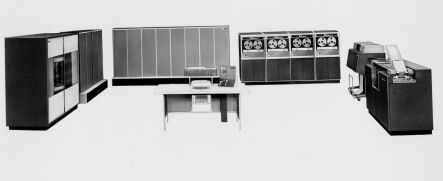 |
Note:
I loved running the IBM 1410! One sat at the console and had complete control over running the system. One loaded the tapes, ensured the disk drive was active, and was able to check if there was a bad record on a tape and correct it in memory, skip the bad record, and restart processing. You could initiate the job, run it to a successful conclusion and then print out the product and send to the appropriate sources. One felt like he or she was on the command deck of the Star Ship Enterprise.
Later with the IBM 360s and 370s, one sat at the console and the computer ran itself. Another group setup the job stream and it was automatically run by the computer. Even though there were problems, it wasn't the same.
|
Announced September 12, 1960 and withdrawn March 30, 1970.
A. The IBM 1410 Data Processing Card System was a high-speed flexible system containing large volume storage facilities and fast input/output units for up-to-the-minute, accurate punched card output and printed reports.
- IBM 1402 Card Read Punch
- IBM 1403 Printer
- IBM 1411 Processing Unit
- IBM 1414 Input/Output Synchronizer, Model 3 or 4
- IBM 1415 Console
B. The IBM 1410 Data Processing Tape System added to the speed and efficiency of the 1410 Card System with high volume storage capacities and increased data input/output speeds. The 1410 Card System could be expanded to include:
- IBM 729 II Magnetic Tape Units with the 1414 Input/Output Synchronizer, Model 1
- IBM 729 IV Magnetic Tape Units with the 1414 Input/Output Synchronizer, Model 1
- IBM 7330 Magnetic Tape Units with the 1414 Input/Output Synchronizer, Model 2
IBM System/360 Model 40
|
The Model 40 made its debut in April 1964 as part of the IBM System/360 roll-out. It was a powerful stand-alone system in the medium price range with communication facilities. |
Fireman's Fund Insurance with an IBM System/360 Model 40 and the swing shift operators and shift supervisor,
Charles W. Buntjer
- front and lower center. Since Fireman's Fund Insurance had one of the largest computer centers on the west coast, we had IBM Service and testing at our installation. By allowing testing of new computer equipment, we had on-site maintenance which at that point in time, was invaluable due to the newest installation of main frame computers. We also had some of the most bazaar equipment being tested and most of the time, it never made the market place!
|
IBM System/360 Model 65 Operator's Console
|
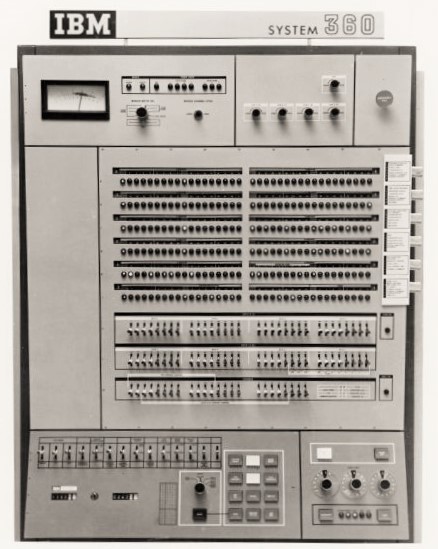 |
The Model 65 was introduced a year after the initial System/360 launch and was first shipped -- to MIT's Lincoln Laboratory -- in November 1965. This is the operator's console on the computer's IBM 2065 central processing unit.
Note:
This was a huge mainframe and we felt like we were on the vanguard of the computer age! At this point I was working in the computer center as a part time assistant supervisor/computer operator, worked in Tech Support, Data Entry, Quality Assurance and Documentation Standards. I sometimes was asked to come and see why something didn't work.
I remember one time I sat at the console and everyone hovered over me and I got mad and told them to keep the 'F' away from me! They all were shocked and asked me what I had said. I said I couldn't figure out the problem with them hanging over me and mumbled some more. It must have sounded all right as they did leave me alone. For some reason, some people are good at certain things and I could just sit there for a while and fiddle around and suddenly the system would take off.
I heard the staff one night telling each other, "We should ask Chuck to see what is wrong as he seems to be able just to sit there and eventually fix the problem!" I thought that was very nice and true, sometimes one just has a second sense on certain things. Strange but true! Too bad we can't be that way with all problems!
|
IBM System/370 Model 145
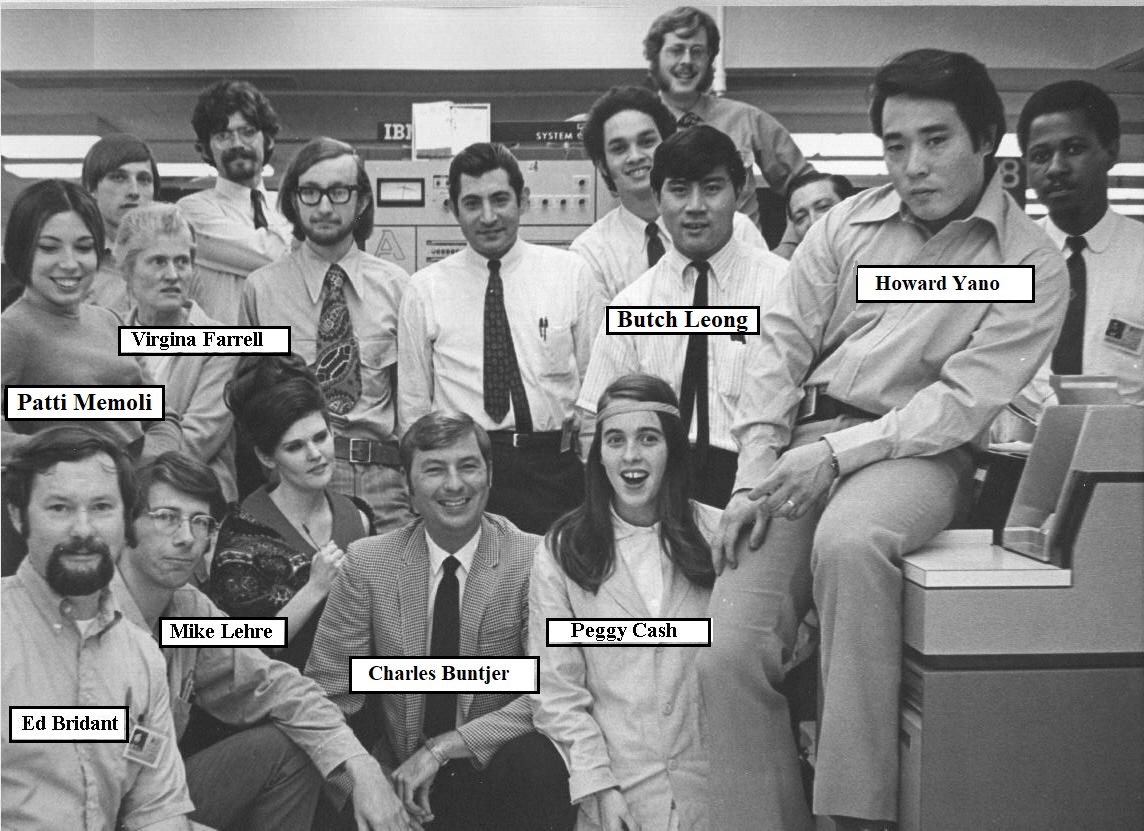
Note - This Photo was taken on December 2nd, 1969:
Patricia Memoli Wood, on the left of the photo in front of the IBM System Model 40, told me when she was hired as a tape certifier in 1968, we had 11,000 tapes in the tape vault! We eventually were the Beta test site for the IBM System Model 370 and had approximately 17,500 tapes at that point. We had people working in the tape vault just to gather tapes needed to run jobs and also to restock them in the correct slot after being processed When we converted to the 370s, we went to disk packs and that basically, was the end of tapes and tape drives!
Note - A New Name Added:
Donald Moriguchi saw this photo on Facebook in 2021, 52 years later, and contacted me with the name Howard Yano!
Announced September 23, 1970 and withdrawn November 10, 1971
The following is the text of an IBM Data Processing Division press release distributed on September 23, 1970.
In a major departure from conventional computer technology, International Business Machines Corporation today introduced its first computer using a main memory made entirely of monolithic circuits.
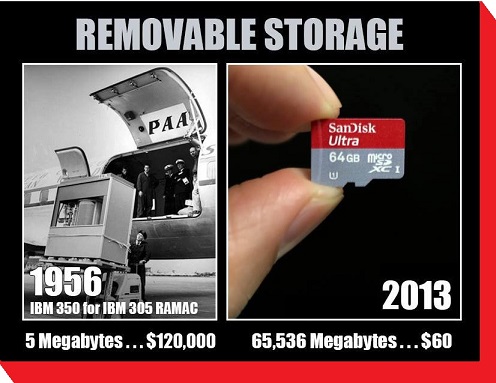 To store its data and instructions, the new IBM System/370 Model 145 uses silicon memory chips, rather than the magnetic core technology that has been the mainstay of computer memories for the past 15 years. More than 1,400 microscopic circuit elements are etched onto each one-eighth-inch-square chip.
To store its data and instructions, the new IBM System/370 Model 145 uses silicon memory chips, rather than the magnetic core technology that has been the mainstay of computer memories for the past 15 years. More than 1,400 microscopic circuit elements are etched onto each one-eighth-inch-square chip.
Monolithic circuitry also is used throughout the Model 145's central processor to perform all of the system's arithmetic and logic functions.
"When we introduced System/370 three months ago," said Thomas J. Watson, Jr., chairman of the board of IBM, "we thought it would do very well, but it has done even better than we expected. We believe that Model 145, with its significant advance in technology, the monolithic main memory, will make the capabilities of System/370 available to an even wider range of users."
With the Model 145, many more business and scientific users can obtain the increased performance-per-dollar advantages of System/ 370. They will not have to reprogram their existing applications written for System/360 and earlier IBM computers. The first models of System/370, the 155 and 165, were introduced in June for users of larger systems.
"In the Seventies, up-to-the-minute information from a computer data base is as vital to the people who run medium-sized organizations as it is to those who run large ones, "said F. G. Rodgers, president of IBM's Data Processing Division. "The Model 145 has all the characteristics needed to make advanced data base applications practical and profitable for intermediate system users."
"The innovative technologies in Model 145 represent significant engineering achievements," Mr. Rodgers said, "but even more important is how they add up to better performance, efficiency and economy for the user."
One of the key advantages of the Model 145 for multiprogramming and data base applications is its ability to use IBM's newest and fastest disk storage devices. They include the IBM 3330, announced in June, and a new disk storage facility, the IBM 2319, announced today. The 2319, available only with the Model 145, has a capacity of 87-million characters of information, expandable to 233-million. It attaches to the central processor, thereby eliminating the cost of a separate disk control unit.
Equally important are new program products announced today for handling data base applications using remote terminals. IBM's Customer Information Control System (CICS), previously available only for large systems, will be available in two Disk Operating System versions. They are designed to assist users in speeding such information as customer account records, inventory status, production and engineering data and student records to where it is needed, while allowing the files to be updated directly from the computer terminal.
Monolithic main memory
In conventional memories, data is stored in magnetically charged cores strung on wires. The use of monolithic memory technology, with its very high circuit density, allows IBM to offer Model 145 users more than a half-million characters of high-speed storage in about half the space that would be required by core planes for an equivalent amount of memory. The more than 1,400 circuit elements on each monolithic chip are interconnected to make up 174 complete memory circuits.
IBM has pioneered the use of monolithic memory technology in its highest performance computers, which include System/370 Models 155 and 165 and System/360 Models 85 and 195. In those systems, monolithic memory technology is used in high-speed buffers that match the speed of very large main core memories to that of the central processors.
The Model 145's internal operating speed is up to five times faster than that of the widely used System/360 Model 40, and up to 11 times faster than the Model 30's. Users have a choice of six main storage capacities, from 112,000 to 512,000 characters -- twice the maximum available with System/360 Model 40.
The ability to run programs written for earlier IBM computers, including the 1400 Series and 7010, is provided with the Model 145 at no additional charge. Users can also run Disk Operating System programs under control of the more powerful Operating System without reprogramming.
Reloadable control storage
Another innovation that enhances the Model 145's efficiency is a reloadable section of monolithic memory that augments the main memory. It is called Reloadable Control Storage (RCS).
The code for the basic System/370 instruction set, including all system control functions, is stored in the RCS. Users will be supplied with a prewritten disk cartridge containing all needed instructions, as well as those for selected optional functions. Options might include the instructions that enable the Model 145 to emulate earlier IBM machines or perform arithmetic with extended precision to 34 decimal digits.
The console operator can load instructions from the disk cartridge into RCS in about 45 seconds. The standard 32,000 characters of control storage provided with each Model 145 can be expanded to 64,000 by using a portion of main memory, if needed, to accommodate optionally available functions.
Blue Cross of California ~ 1981 to 1986
Senior Business Systems Analyst
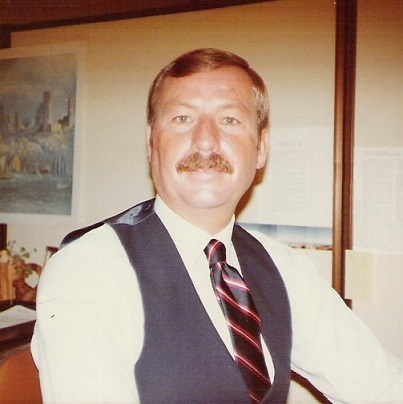
|
Maintain and develop an on line claims entry system along with problem solving and state wide network support between host and regional sites.
Determine user, operations, and programming needs in documenting procedures such as:
- Develop and publish documents for Operations Standards Procedures and assist application and programming
- Teams in designing applications
- Design a claims on line data entry user guide
- Document procedures and programs
- Design and document application JCL and PROCs
Note: I had tried to go to Egypt once before and this time I went to the travel agent and they had a note on their PC stating Chuck Buntjer shouldn't go to Egypt! I asked what that was all about and they said there had been two terrorist attacks on travelers so suggested Fiji. Two weeks later I was lying under a palm in the sand but... not in Egypt, in Fiji! I had a great time there and eventually did make it to Egypt!
|
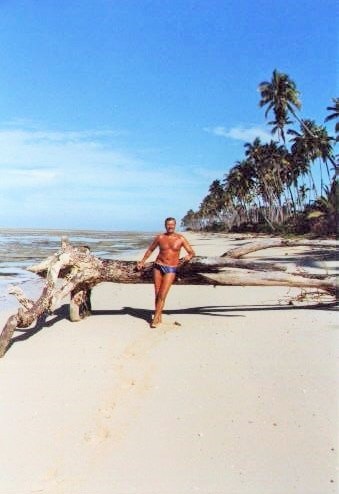
|
Consulting Over the Years ~ 1987 - 2002
Some of the many companies I have worked on since 1987.
- Boole & Babbage Software
- Sterling Software
- IBM
- William-Sonoma
- Deltanet
- Wells Fargo
- Visa
- Schwab
- Banc of America - Y2K Fix
- Franklin Templeton - Security
- and many other corporations in the Bay Area
|

|
Bank of America, Concord, CA - January of 1987 to August of 1988
The Computer Resources Group, Inc. San Francisco, CA - Senior Business Analyst/Technical Writer
Work with the Large Scale Systems Division and Operations Division in analyzing and formatting the necessary information to publish manuals for Disaster Recovery, Program Documentation, and Operation's run books. The major systems documented were TPF; MVS, IMS, CICS, Database-2 and all utility programs needed to achieve systems recovery. The following manuals were created after data gathering from approximately 60 programmers and technical personnel in the San Francisco and Los Angeles computer centers:
- Disaster Recovery Manual for the San Francisco and Los Angeles operating systems
- Program Documentation Manual for vendor products and internal programs
- Operations run book for ease in running systems and application jobs
Boole & Babbage, Sunnyvale, CA - August 1988 to January 1990
The Contractor's Network, San Francisco, CA - Senior Business Analyst/Tech Writer
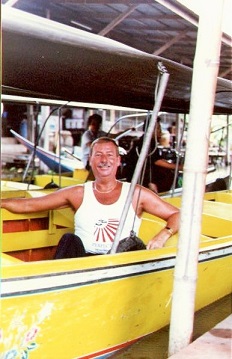
|
Worked with engineering staff, software design specialists, and users to analyze, format, and publish mainframe operating systems software package information and formalize documentation standards:
- AutoOPERATOR Installation and Administration User Guide
- AutoOPERATOR User Guides for MVS, CICS, and IMS operating systems
1989 Earth Quake ~ Thailand
I was taking a trip to Thailand and decided to work late so I could leave withing a few days. I was alone, sitting at the computer when the building swayed. It is a one story wood building and I told myself, "Its about time we had a quake to relieve the pressure!" Well the lights went off, the building shook and I was not amused so I got up and stood against the wall. After about 15 minutes the lights came on so I did some more work. I left around 11 p.m. and was stopped by the police and told to stay put and not try to drive back to the City. So I finished the work needed to get me to a point to go on vacation and I left a note I would return in two weeks. The airport was closed down but it reopened in a few days, just in time for me to fly to Thailand and a great vacation!
|
Sterling Software, Palo Alto, CA - January 1990 to January 1992
|
Managed all phases of analyzing and documenting the Space Management System, which will run under the OS/2, MVS
operating system on IBM mainframes using OS/2 Hypermedia Information Presentation Facility (IPF) tags. Use WORD for Windows to produce:
- a Product Specifications Function report from engineering and management input
- an External Functional Specifications report from engineering, programming, and management input.
- Design corporate documentation standards using the on line OS/2 hypermedia format and include the following items:
- Context sensitive Help panels for on line screen fields
- Icon sensitive Help panels for activity displays
And another vacation, this time to Hong Kong and Machau!
|
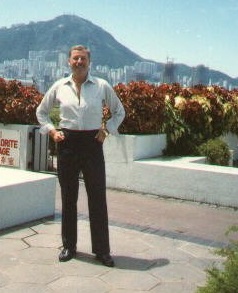
|
Williams-Sonoma, San Francisco, CA - Februrary 1, 1997 to May 15, 1998
All Star Consulting, San Francisco, CA ≠ Senior Technical Writer
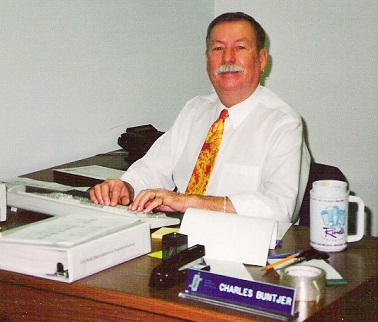
|
Worked with programmers to document AS400 programs for updating applications to fit user's needs by using WORD for Windows 6.0.
And during this consulting job I vacationed in China for a few weeks!
|

|
Banc of America Securities, San Francisco, CA - July 20, 1998 to March 31, 2000
The Y2K Division also took me out for a fantastic 60th Birthday Party!
David Hicks Associates, Inc. Lafayette - Senior Tech Writer/Business Analyst/Tester
Worked on a Data Warehousing project to document databases and reporting for BackOffice. Used PLATINUM Erwin 3.5.2 as
 a data-modeling tool to document databases fed by ADP and other vendors to feed the new CDR database-reporting project. Also documented report layouts using Micro Bank to include report fields and data base criteria for data selection for conversion to Acutate.
a data-modeling tool to document databases fed by ADP and other vendors to feed the new CDR database-reporting project. Also documented report layouts using Micro Bank to include report fields and data base criteria for data selection for conversion to Acutate.

Worked with Application Development Department to document the interfaces with other departments such as Quality Assurance, Modularization, Change/Release Control, NT Administration and so on. Detailed how the department documents work flows to use other department resources. Determined where bottlenecks occur and how they may be resolved. Set up a web site for inter-office access of related information plus listed related URL's that access other department documents that will make the Application Development Department a more productive area.
I worked in both of the buildings shown as shown on the right. The stock brokers worked in the Transamerica pyramid and the computer center was in the new building across the street from the pyramid. This was a great location to work and play at the height of the dot-com era!
Acted as liaison between the Information Technology Department (IT) and Quality Assurance Department (QA) to ensure Y2K testing of vendor packages were completed in a timely fashion. Created Assessment Forms and reviewed the test results and ensured the Y2K compliance memo of acceptance was submitted to IT for approval by management to complete the Y2K compliance testing phase.
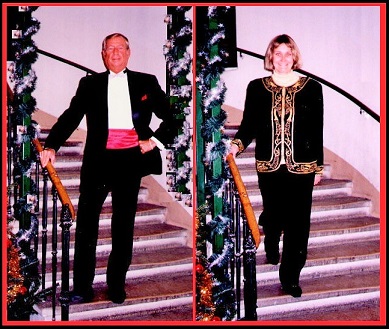
Also set up testing standards for the Year 2000 program changes and documented the test scripts for nine systems in the Montgomery Securities BackOffice Division. Assumed testing lead over three teams to coordinate and ensure the base line testing was followed correctly. Documented results from the base line testing and used the results to set up the testing criteria for Y2K production testing for each test script. Tested systems against the current production environment and against the production environment with the Y2K program changes in place to determine if the results were the same. Finally tested the systems against the Y2K program changes with aged data to ensure all of the Y2K program changes match the test criteria. Results are reviewed and reliability determined by the auditors and the SEC for final approval of the Y2K testing for the first phase of reconfiguration of the Y2K interactive program changes.
The above projects were accomplished by using WORD for windows 6.0, Power Point Presentation Manager, Adobe Acrobat, Excel, Visio, Front Page (HTML Tags), Actuate Developer, Micro Bank, PLATINUM ERwin 3.5.2 Data Modeling Tool, and AS 400 RPG programs along with GAMMA and Hawkeye.
I was lucky to take off two weeks at the end of 1999 to celebate the Millennium New Year with my friend Viviane. We flew to Austria and spent two weeks in Vienna and then took a train to Budapest Hungry for the day. We planned next year to go to Morocco for the real Millennium New Year.
Schwab, San Francisco, CA - April 1, 2000 to December 31, 2000
All Star Consulting, San Francisco, CA ≠ Web Administrator/Business Analyst/Tester

|
Built a knowledge
base using MindManager to detail the organization and design a new web site using DreamWeaver for the SIM Technology Group while maintaining the old SIM Tech web site using RoboHelp.
Also became a member of the ICON (Intranet Standards) Group in order to discuss ongoing maintenance problems and set standards for in-house web sites. Used the knowledge base, standards from the ICON Group, and input from brain storming sessions with the SIM Technology Group to create a GUI interface for the SIM Tech web site using Photo Shop and DreamWeaver. Also used MetaBot to create a template and meta tags for searching the web site using an in-house search engine. Created and maintained the files on NT ClearCase.
Created Release Notes for QA testing using Vantive and Packaging Notes for Release Management and created test cases for QA from Use Cases.
The above projects were accomplished by using MindManager, DreamWeaver HTML Editor, MetaBot, Map This, Photo Shop, Paint Shop Pro, WORD for windows 6.0, Power Point Presentation Manager, Adobe Acrobat, RoboHelp 7.0, NT Clear Case, Vantive, and Visio Flowcharting Tool.
And you can see at the end of this contract Viviane and I flew to Morocco and traveled by train and car all over Morocco. We celebrate in Marrakech, the real Millennium New Year, 2000 and 2001! And we did celebrate the first Millinnium New Year in Vienna Austria in 1999 and 2000!
|
Franklin Templeton Technology, Dublin, CA ≠ February 1, 2001 to September 1, 2001
All Star Consulting, San Francisco, CA ≠ Web Administrator/Business Analyst/Tester
Created an in-house Information Security Intranet web site and worked with the users to add documents and links to the site for better use by corporate personnel.
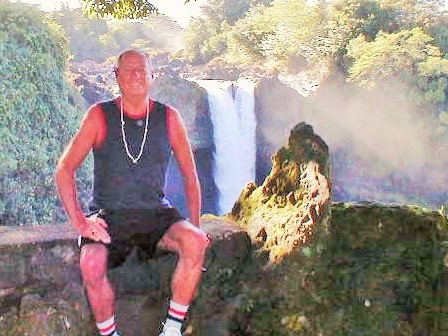
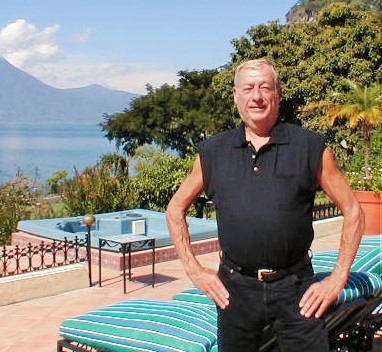
Created a Project Methodology web site that documents all phases, modules, and deliverables for creating or updating an application. This is used by the Security Division to setup time lines, resources, and necessary documents to ensure the security policy for the corporation are met by the user. I also reviewed, reformatted, and designed new forms such as the Project Security Checklist for project manager's use in detailing the necessary actions and documents needed for review by the Security Facilitator Reviewer. I created a `cheat sheet' for project managers and security reviewers to use detailing the phases of a project, the modules and deliverables.
I also did miscellaneous project such as reviewing of the server audit trails and matching the audits against the Policy Standards. Failed audits were returned to the appropriate personnel for corrective action. All of this was accomplished using MindManager, DreamWeaver, Word, and Visio.
After I retired I really started to travel around the world. In 2002 I went to the big island of Hawaii for my 62nd birthday. Here I am in 2003 in Guatemala. I have been in about 40 countries so far and to many locations others haven't been to. Exciting being retired!
Over 50 Years in the Computer Business
I retired in 2002 but continue today to work on web developement. Can you imagine, over 50 years in the business, starting out with punched cards and wiring boards, working with Main Frame Computers, then consulting for major businesses and finally having my first laptap computer built for me in 1998.
|
I may be retired in 2006 but I still work on some consulting projects for people, especially setting up internet web sites. |
My 2005 note book computer is equivalent to a mainframe computer in 1960!
|
And now in 2015 we have Smart Phones, I-Pads, Smart TVs and wrist watches that were visualized in the 1900s via the TV show Star Trek and comic book characters with the wrist watches one could talk on. I think that might have been Bat Man! We how have voice recognized software that can answer almost any guestion one might ask it on a phone or wrist watch. We now have virtual reality and who knows what other things be invented in the near future!
|
2022 and over 60 Years in the Tech Business
|
I am still working on my website, 22 years so far. I also am contracting out to do websites, iMovies, YouTube uploads and Playbills for various clients. Check out my personal website and one of the contracting jobs I have worked on for a start up student Opera Company.
|
2022 and Traveling the World
|
I am still able to keep traveling all over the world. On the left I am celebrating my 80th birthday in 2020 on the Indian Ocean, cruising from Dubai and Amon to India and Sri Lanka!
On the right, I took the train, AMTRAK, to Reno for a few days for my 82nd birthday in 2021. Wonderful weather and lots of sight seeing. Wonder where I will go on my next birthday!
I also took a cruise in 2021 and visited Barcelona, Malaga and Cadiz and on to the Azore Islands and ending up in Newark.
|
60th Anniversay of Living in San Francisco - 1963 to 2023
|
I was 23 when I was drafted into the Army in 1963. Because I started in the tech business when I was only 19 years old, I was the only Private to be sent to the Presidio of San Franciso to work in the computer center, a plum job as everyone told me. They were correct!
I lived in various places in the City but finally in 1975, I bought a condominium on Twin Peaks with a great view. Only problem was one needed a car to get around, especially at night and also if I had contracts out of the City.
After 18 years living on Twin Peaks, I decided I didn't want the expense of a car and sold my condo and moved downtown into the Fox Plaza Apartments next to City Hall, the theatres and shops. Also, almost all the busses ran past my place and the subway system, BART, was a block away. Saving all this money allowed me to even travel more around the world. I have been living at the Fox Plaza Apartments for 30 years now! 1993 to 2023!
Here is my view from the 28th floor of my apartment! Who would have thought, a 19 year old from Illinois and the farm would end up living in the City with such a view. I am so lucky!


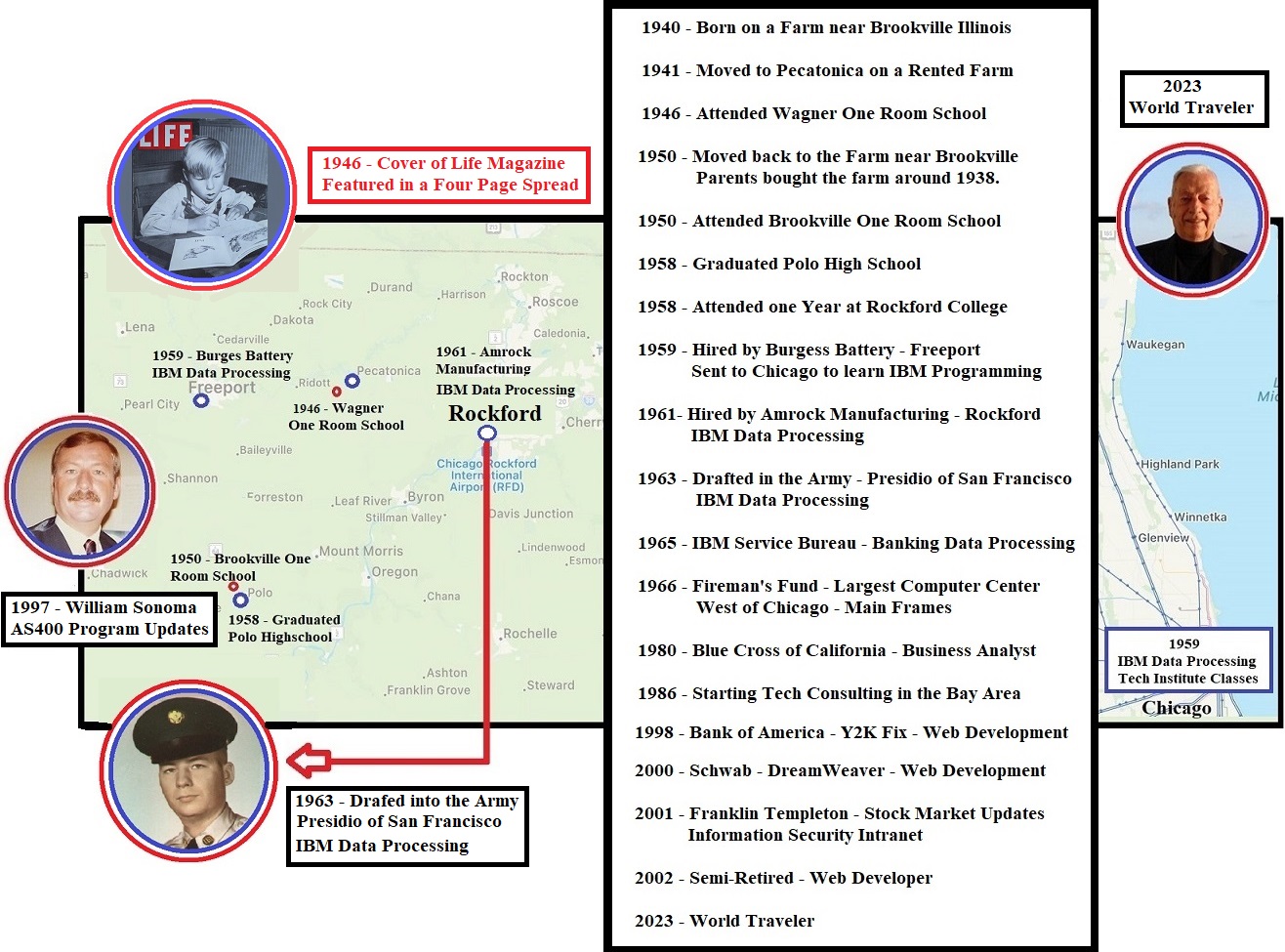
 I interviewed at Burgess Battery, but without any experience, believed my chances of getting the job was nil. After a month had gone by I had forgotten about the job, no day dreaming at that point in time.
Then I heard my step-mother yelling for me from the house that there was a phone call from me from Freeport, long distance. I wondered who that could be! She was as excited as I was!
I interviewed at Burgess Battery, but without any experience, believed my chances of getting the job was nil. After a month had gone by I had forgotten about the job, no day dreaming at that point in time.
Then I heard my step-mother yelling for me from the house that there was a phone call from me from Freeport, long distance. I wondered who that could be! She was as excited as I was!
 company in Rockford that manufactured machine tools. The last job I had was at Amerock in Rockford and my boss there wanted me back there after my military service. They did have a large installation when I was drafted but after seeing San Francisco and the Pacific Ocean and of course, Los Angeles, Hollywood and Monterey, I was hooked, never to return to the Midwest!
One evening after work, I was sitting in a bar having a cocktail before going home for dinner. There on the TV was an announcer stating there were missiles 90 miles off the coast of Florida and pointed at the major cities along the Atlantic Coast. Needless to say I wondered what that meant! Well shortly after I received a special letter in the mail stating I needed to go for the induction process to enter the Army! I was not a happy camper but as you will see, things did turn out all right!
company in Rockford that manufactured machine tools. The last job I had was at Amerock in Rockford and my boss there wanted me back there after my military service. They did have a large installation when I was drafted but after seeing San Francisco and the Pacific Ocean and of course, Los Angeles, Hollywood and Monterey, I was hooked, never to return to the Midwest!
One evening after work, I was sitting in a bar having a cocktail before going home for dinner. There on the TV was an announcer stating there were missiles 90 miles off the coast of Florida and pointed at the major cities along the Atlantic Coast. Needless to say I wondered what that meant! Well shortly after I received a special letter in the mail stating I needed to go for the induction process to enter the Army! I was not a happy camper but as you will see, things did turn out all right!


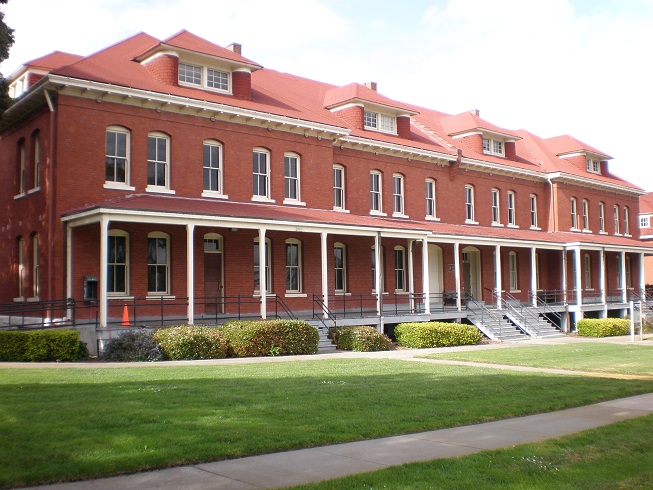










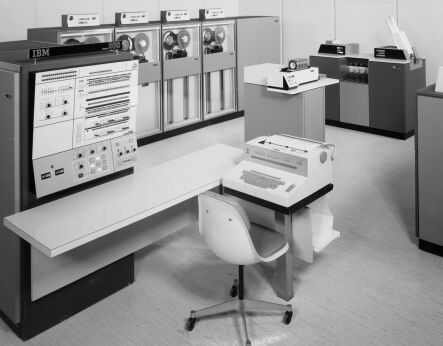
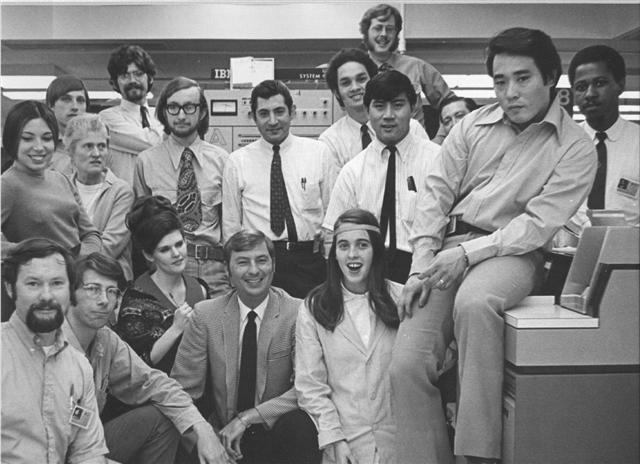


 To store its data and instructions, the new IBM System/370 Model 145 uses silicon memory chips, rather than the magnetic core technology that has been the mainstay of computer memories for the past 15 years. More than 1,400 microscopic circuit elements are etched onto each one-eighth-inch-square chip.
To store its data and instructions, the new IBM System/370 Model 145 uses silicon memory chips, rather than the magnetic core technology that has been the mainstay of computer memories for the past 15 years. More than 1,400 microscopic circuit elements are etched onto each one-eighth-inch-square chip.






 a data-modeling tool to document databases fed by ADP and other vendors to feed the new CDR database-reporting project. Also documented report layouts using Micro Bank to include report fields and data base criteria for data selection for conversion to Acutate.
a data-modeling tool to document databases fed by ADP and other vendors to feed the new CDR database-reporting project. Also documented report layouts using Micro Bank to include report fields and data base criteria for data selection for conversion to Acutate.






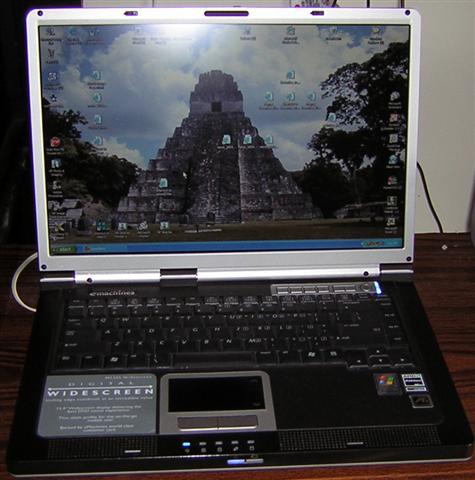


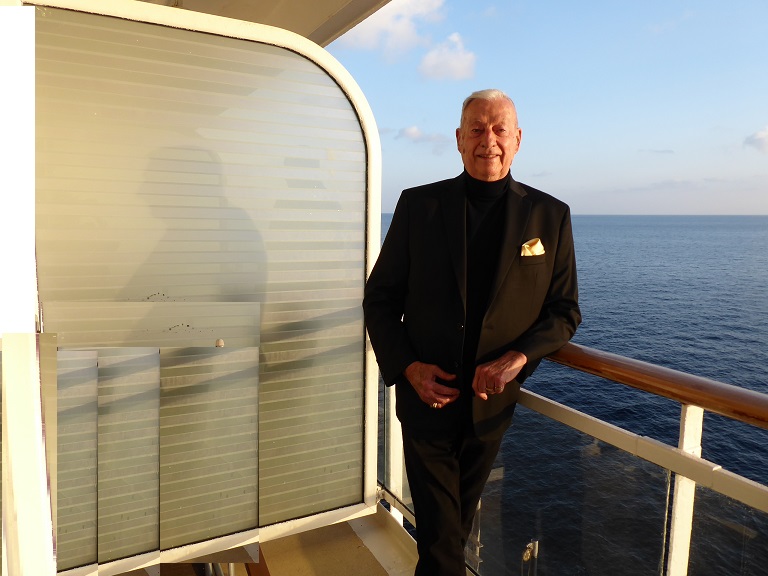

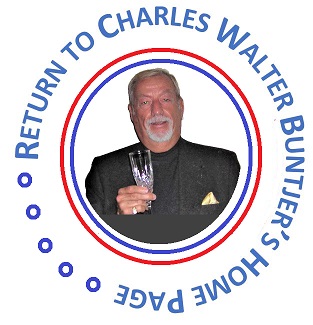 Buntjer's Home Page
Buntjer's Home Page